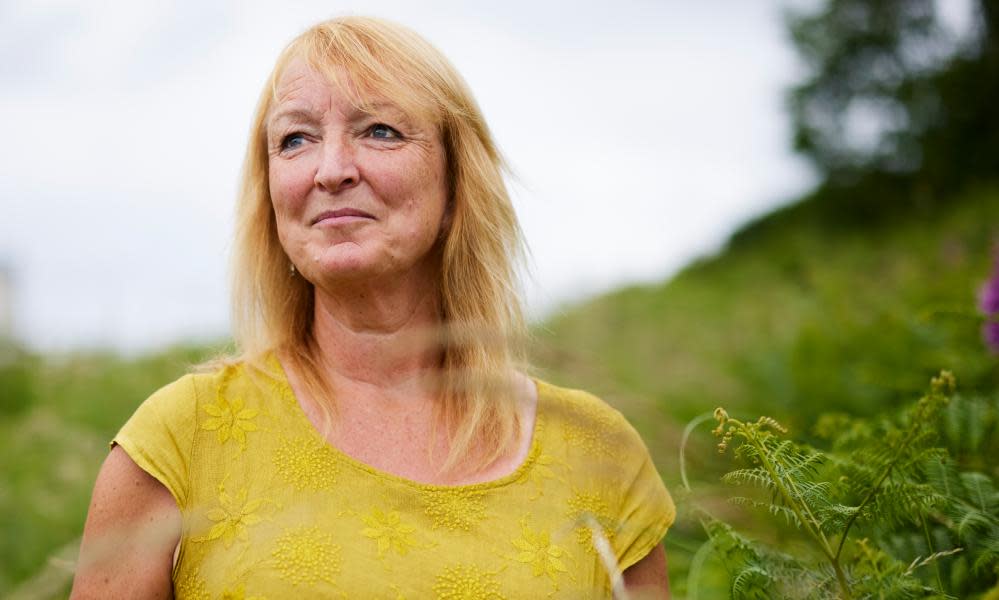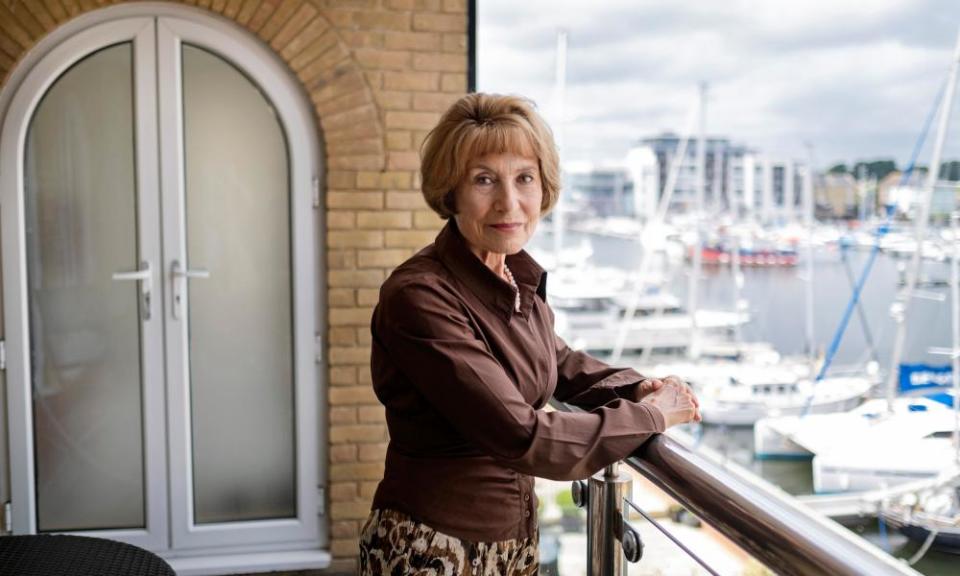‘It messes with you mentally’: the fear, swelling and stress of life with lymphoedema

Five weeks after being diagnosed with cervical cancer, Corinne Singleton was declared to be in remission. She skipped out of the oncology ward that day, ready to make the most of her retirement. Little did she know that her health challenges were far from over. “To be honest,” says Singleton, five years later, “the cancer was a breeze compared with the lymphoedema.”
About a month into her recovery, Singleton, 60, noticed some unusual swelling of her upper thigh. “I just thought I must have banged it,” she says. When it persisted after two weeks, she realised, with a sinking feeling, what was the likely cause. She had learned about lymphoedema early on in her treatment for cancer, as a possible side effect of radiotherapy. “I remembered thinking: ‘I hope I don’t get that one’,” she says.
Lymphoedema is a chronic inflammatory condition affecting the lymphatic system, a little-discussed but crucial part of the immune system, which circulates infection-fighting lymph fluid around the body. When the system is impaired – as a result either of a genetic abnormality, or damage caused by another condition – that fluid builds up and causes persistent swelling, typically in the limbs. So-called “primary” lymphoedema, present from birth, is rare. But as many as 50% of cancer patients who have lymph nodes removed during treatment (often those with breast, prostate or gynaecological cancers, or melanoma) may develop secondary lymphoedema.
In neither case is it fatal, nor even necessarily painful – but there is no known cure, and it may worsen if left unchecked. Though the presentation and impact of lymphoedema varies, patients must typically follow a time-intensive daily programme of skincare, compression, movement and massage to reduce the swelling and the risk of infection. “Once people have it, it’s effectively a lifelong treatment,” says Prof Vaughan Keeley, a consultant physician in lymphoedema at the University Hospitals of Derby and Burton and one of the few such specialists in the UK.
Early diagnosis of lymphoedema has been shown to be vital to slowing its progress and minimising the long-term impact. But too many cases are still being overlooked, even by the medical profession, owing to a lack of understanding.
The fact that more people are living longer, surviving cancer treatment, developing obesity – it means prevalence is increasing
Prof Vaughan Keeley
Until recently, the focus of lymphoedema management and research has been on those cases resulting from the treatment of cancer. But experts have realised that these represent only the tip of the iceberg. It is now believed that only 25% of all cases of lymphoedema (primary and secondary) are cancer-related and tend to be picked up in the course of aftercare. Other triggers are less obvious or understood, and complicated by the presence of coexisting conditions. Diagnoses can consequently be slow to arrive. In its early stages, the swelling is mild, so some people don’t even seek help until it becomes impossible to ignore, Keeley says: “It sneaks up on them gradually.”
As many as 400,000 people in the UK are believed to have lymphoedema, making it a little less than three times as prevalent as Parkinson’s disease and four times as prevalent as multiple sclerosis. The true numbers could be even higher, says Keeley. “The fact that more people are living longer, surviving cancer treatment, developing obesity – it means prevalence is increasing.”
But scant understanding globally – coupled with increasing competition for resources within healthcare, and a certain fatalistic view of conditions that can’t be cured – means there has been little investment put into researching lymphoedema, or supporting those who have it. “It’s one of those things where it’s a bit of a nuisance, it doesn’t kill you and you can’t treat it anyway … so people were just told to go away and live with it,” says Keeley.
Janine Warton, 75, from Eastbourne, was diagnosed with primary lymphoedema in her early 30s. In the 1980s, she says, “there were very few GPs who knew about the condition … It is very depressing, when you learn that there is no cure – I went through that process.”

For many years, Warton felt self-conscious about her swollen foot, wearing only long skirts and covered shoes. But her condition was stable and responsive to compression and massage until about 15 years ago, when the swelling extended up her leg and became permanent. At the time, Warton was advised to have liposuction, which is increasingly recognised as effective in alleviating more severe cases of lymphoedema – but it is not funded by the NHS. “I was very disappointed,” she says.
Instead, Warton had to learn to live with lymphoedema. “I went through a difficult time, some days better than others. Now that I’ve accepted the condition, it’s a lot easier.” Warton sees a podiatrist and a specialist physiotherapist regularly, on top of a gruelling daily programme of self-massage and exercise to support the flow of fluid as best she can: “You get to know what works and what doesn’t.”
There is a lot more awareness of the condition now than there was even 10 years ago, she says – “but I wish it was taught in more detail in medical schools”. The NHS does not have a national strategy for lymphoedema. In England, in particular, says Keeley, “there’s a classic postcode lottery, where some areas are provided for and some aren’t”. As a whole, he says, the condition is “largely ignored”.
You hear of people who have had the condition for years, and the doctor is still telling them they need to lose weight
Corinne Singleton
Singleton was lucky to be swiftly diagnosed, and even luckier to find a specialist close to her home in Cumbria. “You hear of people who have had the condition for years, and the doctor is still telling them they need to lose weight,” she says. “A lot of people have to educate their own GPs … It’s not even well known by a lot of medical staff, so it’s not surprising it’s not known by the public.”
Though Singleton is still active and able to keep up her passion for fell-running, maintaining a stable condition requires constant vigilance. She must follow a rigorous skincare routine, wear thick compression stockings at all times, and recently upgraded her self-massage routine with a £1,000 “LymphAssist” machine, which she must use for two hours every day. But despite diligent daily care, the swelling in one leg has spread to the other, necessitating even thicker compression stockings. “Imagine the thickest, clingiest, tightest tights you’ve ever had to put on,” says Singleton. “I defy anyone to put them on without sticking their tongue out.”
But what is worse than the physical toll is the blow to her sense of her own image. Even when she had cancer, Singleton says, “I didn’t feel particularly incapacitated.” But now, she must factor the condition into her social life, travel and even dating. “If you’re at a restaurant, you can’t just put your feet up,” she says.
Because of their compromised immune systems, people with lymphoedema are at an elevated risk of cellulitis: a bacterial infection of the skin that can quickly develop into sepsis. Even minor cuts can result in admission to hospital – adding to the demands of managing the condition.

The lack of mainstream awareness of lymphoedema is changing, thanks to organisations that connect people with the condition and lobby on their behalf, such as the Lymphoedema Support Network and the British Lymphology Society (BLS). The BLS is seeking to educate healthcare providers and people at risk of developing lymphoedema about simple movements to stimulate the lymphatic system such as heel raises, knee lifts and stretches. These are especially important in light of long stretches of inactivity while working from home. “The lymphatic system is a very important part of the immune system, which we often don’t think about,” says Keeley.
In March, the BLS announced the TV presenter Trisha Goddard – who developed secondary lymphoedema in her arm after being treated for breast cancer, and now wears a compression sleeve – as a patron to raise awareness. Campaigners are hopeful that lymphatic health could undergo the same mainstream transformation as gut health has done over the past decade. Celebrities’ embrace of “lymphatic drainage massage” as a means of tackling bloating suggests it could be the next frontier of wellness culture.
But for the hundreds of thousands of people with lymphoedema, a national strategy would help to smooth out the provision of services. In the meantime, patients who have historically been neglected are speaking out.
Mahogany Geter, 23, from Knoxville, Tennessee, was born with the condition affecting her left leg. “When I was younger, I’m not going to lie, it was a bummer,” she says. “Even though it’s a non-lethal condition, it can mess with you mentally – the stares, people talking about you in public.” Her low self-esteem and sense of isolation led her to neglect her self-care routines. “I just wanted to live my life – I got frustrated with having to constantly monitor myself.” Her leg swelled up to such an extent, it added 45kg (7 stone) to her body weight.
Being in hospital with life-threatening cellulitis was a wake-up call, she says. “I realised I didn’t want to spend the rest of my life unhappy.” An intensive (and, Geter emphasises, expensive) physiotherapy programme is starting to show results, with her lower leg circumference shrinking by 28cm (11in) since May. But what really helped Geter to accept her condition, and get to grips with managing it, was writing about it on social media. “Once I decided to put myself out there, I thought maybe it won’t only help me, it will help everyone else,” she says.
Geter went from never sharing photographs of her lower body to doing a body-positive photo shoot that went viral. She now aspires to be a model, in part to raise awareness for lymphoedema research and support. On Instagram, she describes herself as “that pretty girl with the big leg”. The response online has been more positive than negative, she says: “It feels like a weight is lifted.” Other people who share her condition have told her that they admire her confidence.
“I’m just trying to be me, while bringing lymphoedema into it,” Geter says, “because it’s part of my life and a lot of other people’s lives.”

 Yahoo Movies
Yahoo Movies 
